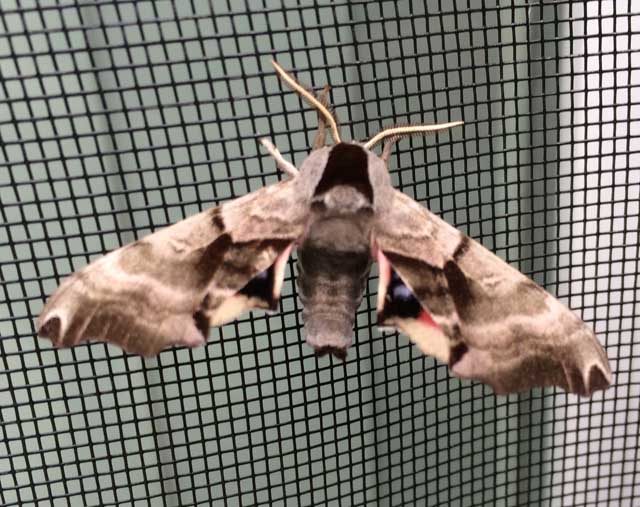Sphinginae subfamily
Sphingini tribe:
 |
Agrius cingulata, Pink-spotted hawkmoth, unlikely stray:
Strong migrant; adults nectar from deep-throated flowers including moonflower (Calonyction aculeatum),
morning glory (Convolvulus), honey suckle (Lonicera), petunia. |
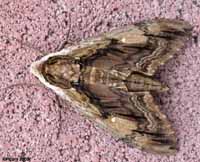 |
Ceratomia amyntor, Elm Sphinx; Four-horned Sphinx: Fw upperside: brown with dark brown and white
markings including white costal area near wing base, dark streaks along veins, and white spot in cell.
Larvae: Elm (Ulmus), birch (Betula), basswood (Tilia), cherry (Prunus). |
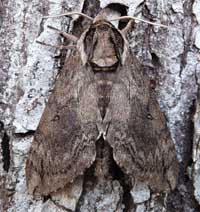 |
Ceratomia catalpae, Catalpa Sphinx.
The upperside of the forewing is yellowish brown with no white markings, but there are indistinct black lines and dashes. The cell
spot is gray with a black outline and the upperside of the hindwing is yellowish brown with obscure lines.
Catalpa is the larval host. |
 |
Ceratomia hageni, Hagen's Sphinx; Osage Orange Sphinx.
The upperside of the forewing is gray with a green tint and has dark indistinct wavy lines, and pale gray patches at the wing tip and along the costa. |
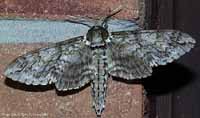 |
Ceratomia undulosa, Waved Sphinx. The upperside of the forewing is pale brownish gray with wavy black
and white lines and a black-outlined white cell spot. |
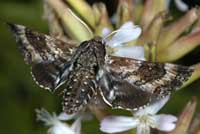 | Dolba hyloeus, Pawpaw Sphinx:
The upperside of the forewing is dark brown with a dusting of white scales. Some moths have patches of reddish or yellowish brown on the
wings. Larve are not limited to pawpaw. |
 |
Lapara bombycoides, Northern Pine Sphinx:
Fw upperside: gray with heavy black bands. Hw upperside: brownish gray with no markings. If you have pines, you might have this species. |
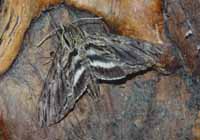 |
Lintneria eremitus, Hermit Sphinx: The upperside of the forewing is gray-brown with wavy lines, black dashes, and
one or two small white spots near the center of the costa. |
 |
Manduca quinquemaculatus, Five-spotted Hawkmoth:
This large bodied moth flies in tobacco fields and vegetable gardens (potatoes, tomatoes) and wherever host plants are found. |
 |
Manduca sexta, Carolina Sphinx: Hw upperside: banded with black and white; has
two black zigzag median lines that are very close together with hardly any white showing between them. Larvae get very large, can strip a tomato plant.
|
 |
Neococytius cluentius, Cluentius sphinx,
unlikely stray: Fw upperside: blurry black with orange markings.Hw upperside: black with orange at
base and orangish yellow patches between veins, forming band across wing. |
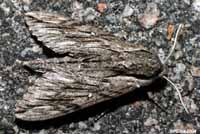 |
Paratrea plebeja, unlikely stray.
Plebeian Sphinx: Fw upperside: gray with indistinct black and white markings. There is a series of black dashes
from the base to the tip, and a small white cell spot. |
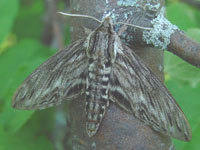 |
Sphinx canadensis, Canadian Sphinx, uncommon, not often reported anywhere,
but it should be present in your county. Larval hosts: white ash (Fraxinus americana); blueberry (Vaccinium). |
 |
Sphinx chersis, Northern Ash Sphinx or Great Ash Sphinx: The upperside of the forewing is soft dark gray to blue-gray with a
series of black dashes, one of which reaches the wing tip. |
 |
Sphinx drupiferarum Wild Cherry Sphinx: Forewings, long and slender, are held close to the body when the
moth is at rest. We have them on P.E.I., but I do not see them nearly as frequently as I see the other Sphingidae. |
 |
Sphinx gordius, Apple Sphinx: Colouration and markings are highly variable from one specimen to another.
The fringes on forewing are mostly black with some white; those on the hindwing are mostly white with a few black patches. |
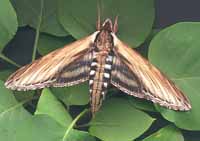 |
Sphinx kalmiae, Laurel Sphinx: The lower forewings are predominantly brownish-yellow with a fairly
wide dark bar along the inner margin. At rest the wings hug the body, giving the moth a long slender look. |
 |
Sphinx luscitiosa , Canadian Sphinx; Clemen's Sphinx:
The upperside of the forewing is yellowish gray in males and pale gray with a faint yellow tint in females. In both sexes, the dark
border on the outer margin widens as it approaches the inner margin. |
 |
Sphinx poecila, Poecila Sphinx:
If you have blueberries in the woods, then you probably have the Poecila Sphinx. |
 |
Sphinx vashti, Snowberry Sphinx:
single-brooded moths fly in montane woodlands and along prairie
streamcourses from April to August.
Fw upperside: narrow black subterminal line
bordered by white inverted V-shaped line on outside, and
black line at apex. |
Smerinthini Tribe:
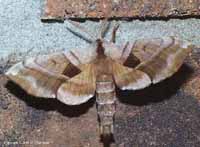 |
Amorpha juglandis
WO,
Walnut Sphinx:
The adults are also highly variable; sometimes wings of an individual
may be all one color or may have several colors, ranging from pale to
dark brown, and may have a white or pink tinge.
See the file for the female; she is different. |
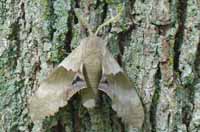 |
Pachysphinx modesta
BAMONA,
Modest Sphinx; Poplar Sphinx:
This moth has a large, heavy body, and
females can be remarkably plump.
|
 |
Paonias excaecata
BAMONA, Blinded Sphinx:
Fw outer margin is quite wavy. There is a dark cell spot and a dark oblique line mid wing from the costa almost to the
inner margin. Basic ground colour is pinkish brown. Flight would be June-July. |
 |
Paonias myops
BAMONA,
Small-eyed Sphinx:
Widespread and common. This species ranges across North America.
The hindwings have a small blue eyespot ringed with black on a yellow background.
|
 |
Smerinthus cerisyi
WO, Cerisyi's
Sphinx; One-eyed Sphinx: Poplars; willows.
Flight would be from late May-July as a single brood.
Look for incomplete light arc near forewing apex.
|
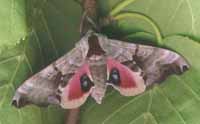 |
Smerinthus jamaicensis, Twin-spotted Sphinx:
Look at right forewing tip where light coloration forms complete letter "c"
by meeting outer margin below apex.
Along the East Coast, it flies from P.E.I. to Florida. |
Smerinthus jamaicensis, Gilberts, August 17, 2014, Dan Morys
Macroglossinae subfamily
Dilophonotini Tribe:
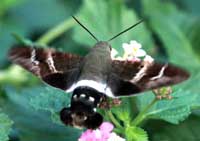 |
Aellopos titan, Titan Sphinx:
Body: dark brown with wide white stripe across abdomen.
Wings: dark brown. Very similar to other species, but
upperside of hindwing has
pale patches along costa and inner margin. unlikely |
 |
Erinnyis ello, Ello Sphinx: Abdomen: very distinct gray and black bands. Female's
fw upperside: pale gray with few dark dots near outer margin. Male's fw upperside is dark gray and brown with
a black band running from base to tip. unlikely stray |
 |
Erinnyis obscura, Obscure Sphinx. At night adults nectar at flowers, including bouncing bet
(Saponaria officinalis); Asystasia gangetica beginning at dusk. July and August are flight times in southern states.
unlikely |
See Hemaris comparison
to help distinguish the next three species.
 |
Hemaris diffinis, Snowberry Clearwing; Bumblebee Moth:
Flies along forest edges and in meadows, gardens and brushy fields. Day-flying adults nectar at lantana, dwarf bush honeysuckle,
snowberry, orange hawkweed, thistles, lilac, Canada violet, etc. |
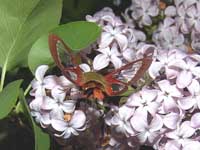 |
Hemaris gracilis unlikely,
Slender Clearwing or Graceful Clearwing: Distinguished from similar species by pair of
red-brown bands on undersides of thorax, which varies from green to yellow-green dorsally and sometimes brown with white
below. questionable |
 |
Hemaris thysbe, the Hummingbird Clearwing:
This interesting day flier is confirmed for Cook and McHenry, and is likely common.
They are widely distributed in the east from P.E.I. to Florida. |
Philampelini Tribe:
 |
Eumorpha achemon, Achemon Sphinx:
It is fairly often reported along the east coast from southern New Jersey
to central Maine. Note the differences between this moth and the Pandorus Sphinx. |
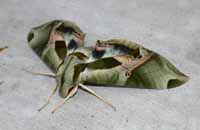 |
Eumorpha pandorus,
Pandorus Sphinx:
If you have Grape or Virginia Creeper nearby, then you probably have
this species. I often get asked to identify larvae from areas where
they have not previously been reported. |
Macroglossini Tribe:
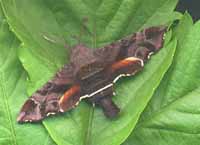 |
Amphion floridensis, Nessus Sphinix:
Widely distributed day flier. If you have Virginia Creeper,
you probably have the Nessus Sphinx. Two bright, distinct, narrow
yellow bands are often visible on the abdomen.
|
 |
Darapsa choerilus, Azalea Sphinx:
They are common in New Jersey and common here on Prince Edward Island.
You will often see this species listed as Darapsa pholus,
especially in older literature. |
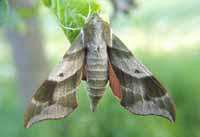 |
Darapsa myron, Virginia Creeper Sphinx;
Grapevine Sphinx: It is widely reported as far north as southern Maine. If you have the
foodplants indicated in the common names, you probably have this
species nearby. |
 |
Darapsa versicolor,
the Hydrangea Sphinx: If you have hydrangea growing near a stream, then you may have the
Hydrangea Sphinx.However, it probably is uncommon.
|
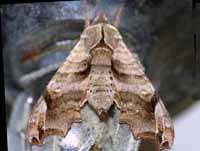 |
Deidamia inscriptum, the Lettered Sphinx: Fw outer margin: deeply scalloped.
The upperside is light brown with dark brown markings. There is small black and white spot near tip.
Hw upperside is orange-brown with dark brown outer margin and median line. |
 |
Hyles gallii, Bedstraw Hawk Moth; Gallium Sphinx:
Not confirmed, but it might be present. |
 |
Hyles lineata, White-lined Sphinx:
Adults usually fly at dusk, during the night, and at dawn, but they
also fly during day over wide variety of open habitats: deserts, suburbs, gardens. |
 |
Sphecodina abbottii, the Abbott's Sphinx:
This moth is very much under reported on USGS. It is a
rapid day flier so is probably not in too many collections.
Grape is a popular larval host.
|
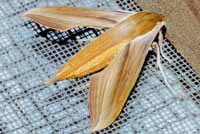 |
Xylophanes tersa possible stray, generally more southerly,
the Tersa Sphinx:
The upperside of the forewing is pale brown with lavender-gray at the
base and has dark brown lengthwise lines throughout.
|
|
|
